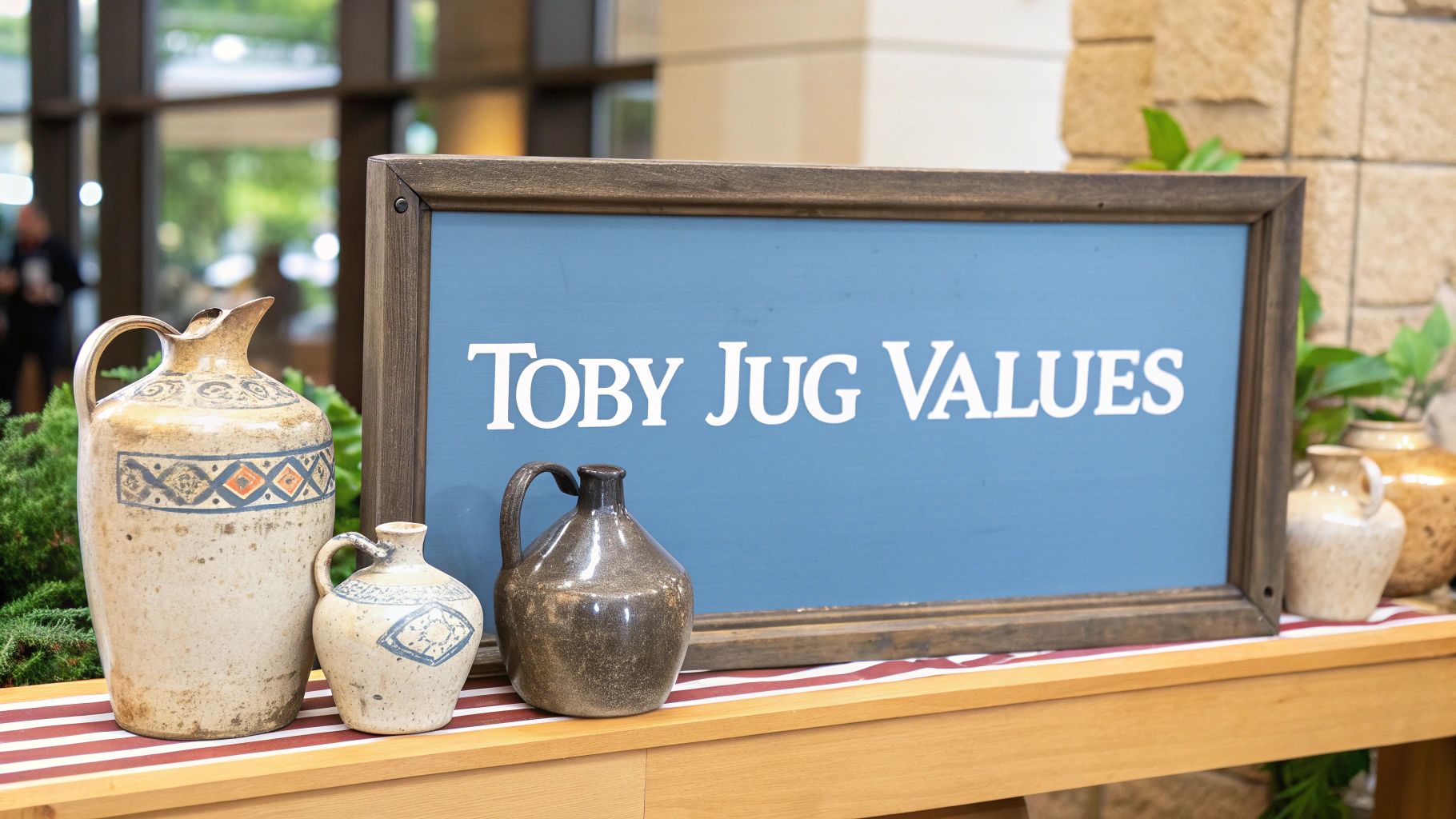When you start looking at Toby jugs, you'll quickly see that their values are all over the map. Some might fetch less than $50, while a rare find could soar well over $5,000. The big question is, what separates the two? It usually comes down to a few key things: its age, the potter who made it, how rare it is, and the condition it's in today. For example, a genuine 18th-century piece from a master potter like Ralph Wood is in a completely different league than a common Royal Doulton character jug from the 20th century.
What Really Determines a Toby Jug's Value
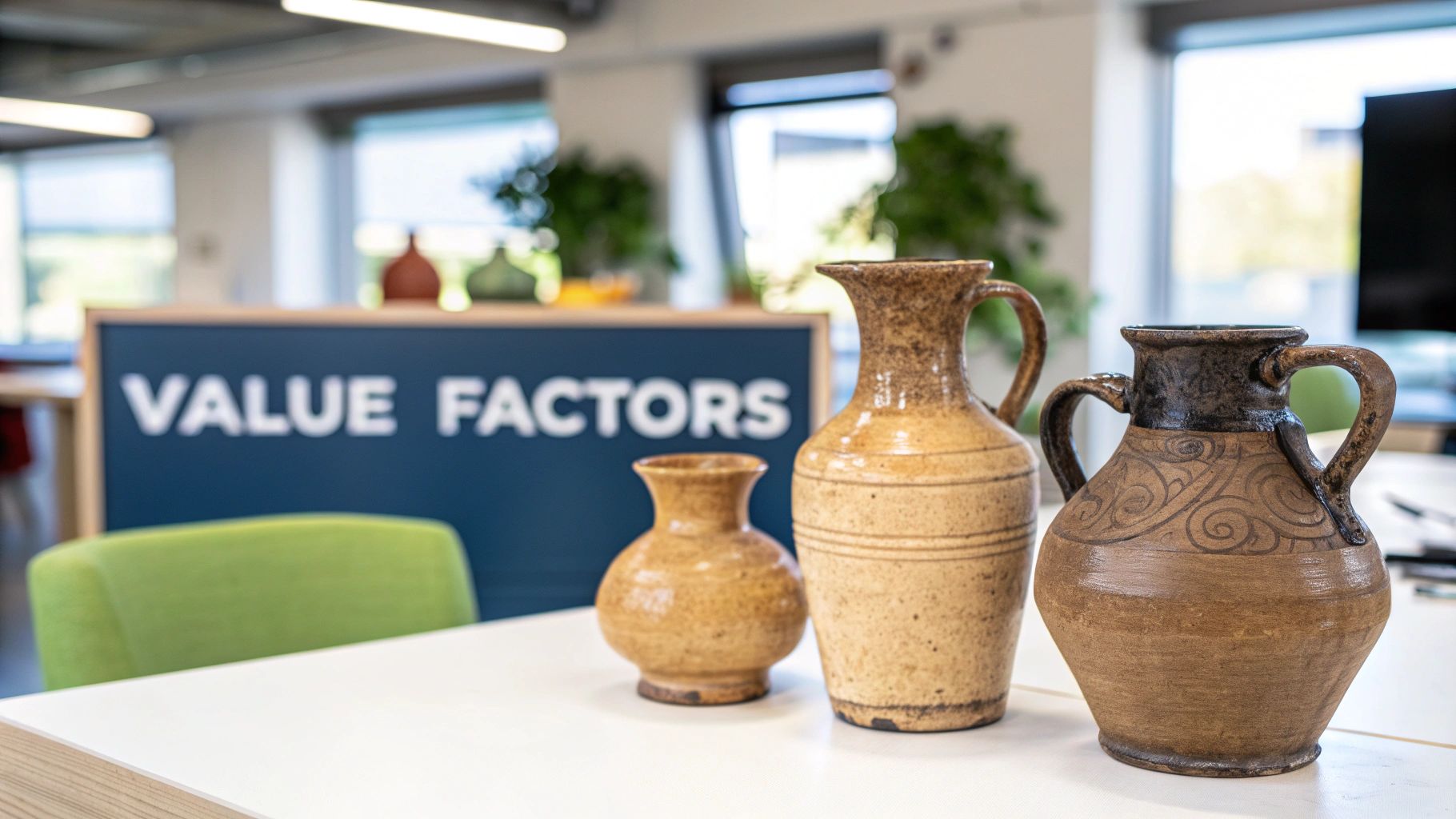
Figuring out what a Toby jug is worth is a bit like being a detective. You can't just look at one clue; you have to piece together all the evidence. The final price tag isn't based on a single detail but on how several key factors come together. It's about building a story for the jug, where its history and physical state are just as telling as the name stamped on the bottom.
Getting a feel for this process will stop you from overpaying for a common piece or, even worse, letting a rare treasure slip through your fingers for a bargain price. Once you learn to weigh these factors, you can look at any Toby jug with a much more confident and knowledgeable eye.
The Four Pillars of Valuation
At the end of the day, valuing a Toby jug really boils down to four critical pillars. Each one gives you a vital piece of the puzzle, and when you put them all together, you get a clear picture of its market value.
- Maker and Marks: Who made it? This is huge. Big names like Royal Doulton, Wedgwood, and the early Staffordshire potters almost always command higher prices.
- Age and Period: When did it come out of the kiln? Jugs from the 18th and early 19th centuries are the real prizes for collectors because they're so much harder to find than the ones mass-produced in the 20th century.
- Rarity and Subject: How many are out there, and who is the character? A prototype or a limited-edition run will always be worth more than a jug that was made by the thousands.
- Condition: How has it held up over the years? A pristine jug with no damage is the dream. Cracks, chips, and shoddy repairs can slash its value dramatically.
A Toby jug's value is a blend of its history, artistry, scarcity, and preservation. No single factor tells the whole story, but together, they reveal its true place in the collector's market.
If you want to get a better handle on the process, it helps to look at the general principles of collectible appraisal. Even though it's about sports cards, the core ideas are the same. You're still looking at condition, rarity, and provenance—skills that apply to any collectible. This background will give you a great foundation as we dive deeper into each of these factors.
How History Shapes Toby Jug Prices
To get a real feel for what a Toby jug is worth, you have to travel back in time. These aren't just quirky ceramics; they're little pieces of history you can hold in your hand, and their story is a huge part of what collectors will pay for them today. Think of it like a first-edition book—its age and origin make it far more important than a modern reprint.
The story kicks off in the famous potteries of Staffordshire, England, right around the 1760s. This was the golden age for these character-filled drinking vessels. Jugs from this period are the absolute holy grail for serious collectors. Their historical context is a massive part of their appeal and, naturally, their price. An 18th-century piece feels like a direct link to the past.
The Original Toby Fillpot and His Influence
The very first jugs were born out of the lively English pub culture of the era. They perfectly captured the image of a jolly, stout gentleman enjoying a pint of ale. This wasn't just a random design; it was tapped into popular culture, the same way a modern Funko Pop is tied to a hit movie.
The Toby jug is a cultural icon from this time, usually showing a seated man, often called a "thirsty old soul." This character is often linked to figures like Toby Fillpot from Francis Fawkes’ 1761 poem The Brown Jug, or even Sir Toby Belch from Shakespeare's Twelfth Night. Because of their incredible craftsmanship and deep historical roots, early Toby jugs from the late 18th to early 19th century are especially prized. You can find more great insights into their origins from the experts at Tennants Auctioneers.
How Eras Define Value
As the years rolled on, the way Toby jugs were made changed, and so did their styles. The journey from the 18th century, through the Victorian era, and into the 20th century saw shifts that directly impact what these jugs sell for today.
18th Century Originals (c. 1760-1800): These are the true treasures. They were hand-painted with rich, earthy glazes by master potters like Ralph Wood. Finding one in good condition is a rare event, and their prices reflect that, often soaring into the thousands of dollars.
Victorian Era Pieces (c. 1837-1901): During Queen Victoria's reign, production ramped up. While they are still genuine antiques, Victorian jugs are generally easier to find than their earlier Georgian cousins. Their value can be significant, but it's typically a step down from the earliest examples.
20th Century and Modern Jugs: With the rise of big names like Royal Doulton, Toby jugs and the newer "character jugs" were produced on a massive scale. While certain limited editions or rare models can fetch a good price, most 20th-century pieces are much more affordable, making them a great starting point for new collectors.
Simply put, the older a Toby jug is, the more likely it is to be rare and handmade. Those two factors—age and craftsmanship—are what really drive its value. The historical period sets the stage for its entire appraisal.
Identifying Key Makers and Their Marks
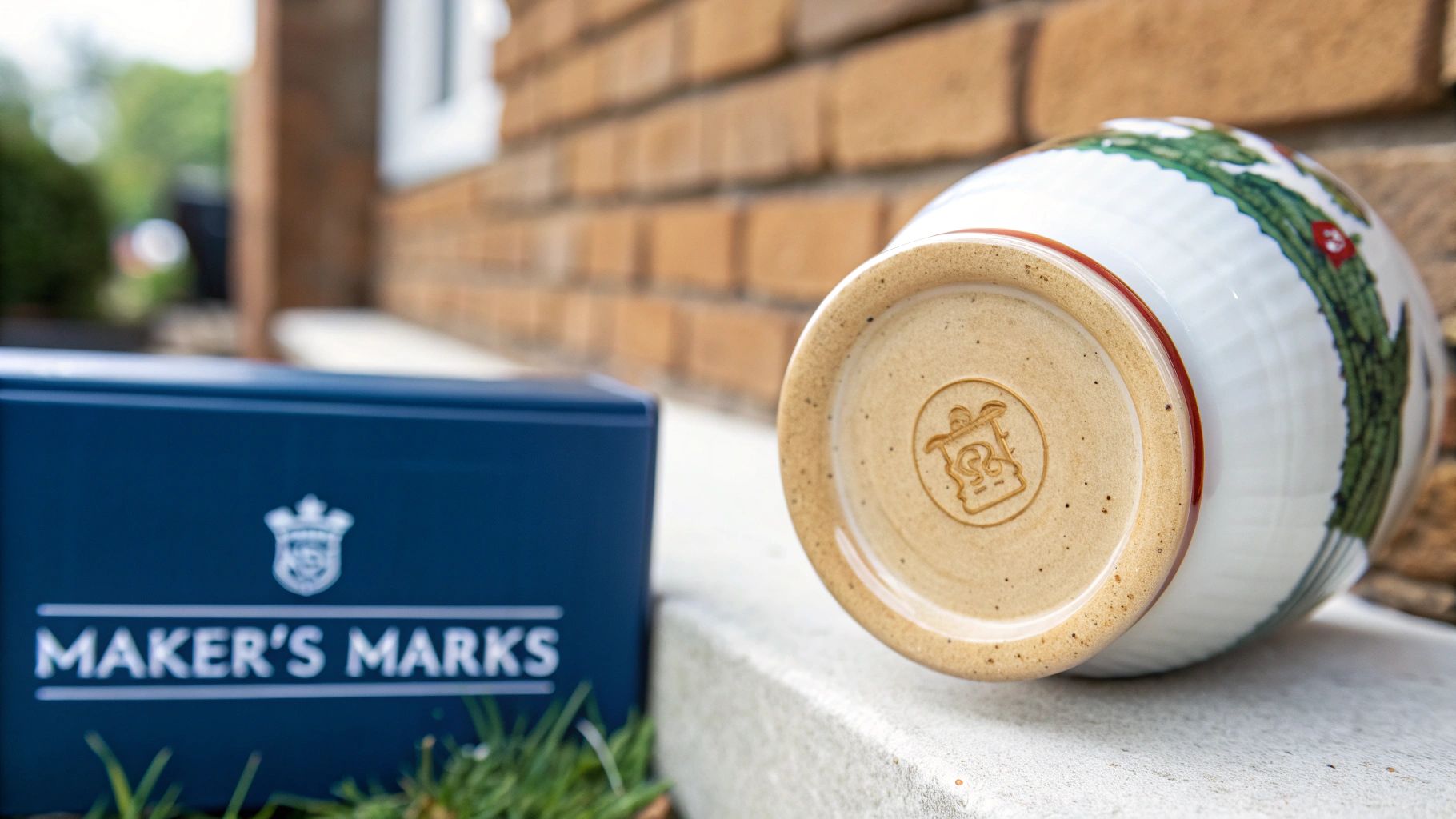
The first thing any seasoned collector does is flip a Toby jug over. That little patch of clay on the bottom is where the real story begins. The maker's mark—a name, a symbol, or even just a scrawled initial—is like a signature on a painting. It can instantly tell you if you're holding a common decorative piece or a rare artifact worth a small fortune.
Think of a prestigious name as a stamp of quality and historical significance. When you see names like Royal Doulton, Wedgwood, or an early Staffordshire potter like Ralph Wood, your collector's intuition should kick in. Learning to spot these marks is probably the single most valuable skill you can develop in determining the values of Toby jugs.
The Most Influential Potters
Over the centuries, countless potteries have tried their hand at making Toby jugs. But only a handful of names truly resonate with collectors and consistently fetch high prices at auction. These are the makers who defined the art form.
- Early Staffordshire Potters (c. 1760s-1820s): This is the holy grail. Potters like Ralph Wood and his family are legends, known for their beautifully crafted early jugs with distinctive, almost runny-looking glazes. Finding an authentic 18th-century piece from a Wood family potter is a collector's dream.
- Wedgwood: A titan of English ceramics, Wedgwood's Toby jugs are all about refined quality and flawless finishes. They weren't the most prolific producers, but the brand's immense reputation means any piece is highly collectible.
- Royal Doulton: This is arguably the most famous name in the game. Royal Doulton practically invented the modern "character jug" (featuring just the head and shoulders) in the 20th century. While thousands of common ones are out there, early or rare examples, especially those designed by Charles Noke, are incredibly valuable.
A maker's mark is more than just a brand; it's a piece of provenance. It connects a jug to a specific workshop, a historical period, and a legacy of craftsmanship that directly shapes its modern-day value.
How to Decode the Marks
So, how do you find and read these clues? It's easier than you might think. Just turn the jug over and have a good look at the base, using a magnifying glass or bright light if needed. If you want to get a feel for the sheer variety of marks out there, checking out a general guide to vintage pottery marks can be a huge help.
You're generally looking for one of a few key identifiers:
- Backstamps: These are the most common. They're stamped, printed, or impressed logos that often include the company’s name. The iconic Royal Doulton lion and crown is a perfect example.
- Incised Marks: This is an old-school technique where potters would literally scratch their name or initials into the wet clay. These marks can be faint and hard to decipher, but they often signal a very early, handmade piece.
- Registration Numbers: Starting in the 19th century, many British potteries began using registration marks or numbers. These are fantastic because they can help you date a piece with incredible accuracy.
To help you get started, the table below breaks down the key features of the most important makers.
Quick Guide to Major Toby Jug Makers
This table offers a snapshot of what to look for from the big names in Toby jug history. Use it as a quick reference when you're trying to identify a piece and get a rough idea of its place in the market.
| Maker | Era of Production | Common Characteristics | Typical Value Range |
|---|---|---|---|
| Early Staffordshire | c. 1760s–1820s | Hand-painted, soft, runny glazes (Whieldon-type), often unmarked or with simple incised names like "Ra. Wood." | $500 – $10,000+ |
| Wedgwood | Late 18th Century – Present | High-quality pearlware or creamware, refined modeling, crisp impressed "Wedgwood" mark. | $300 – $2,500 |
| Royal Doulton | Early 20th Century – Present | Bright, detailed glazes, often featuring famous historical or fictional characters. Clear backstamp with lion and crown. | $50 – $5,000+ |
Keep in mind that these are just general guidelines. A particularly rare or perfectly preserved jug from any of these makers could easily exceed the typical value range. The mark is your starting point for the investigation.
How to Assess the Condition of Your Jug
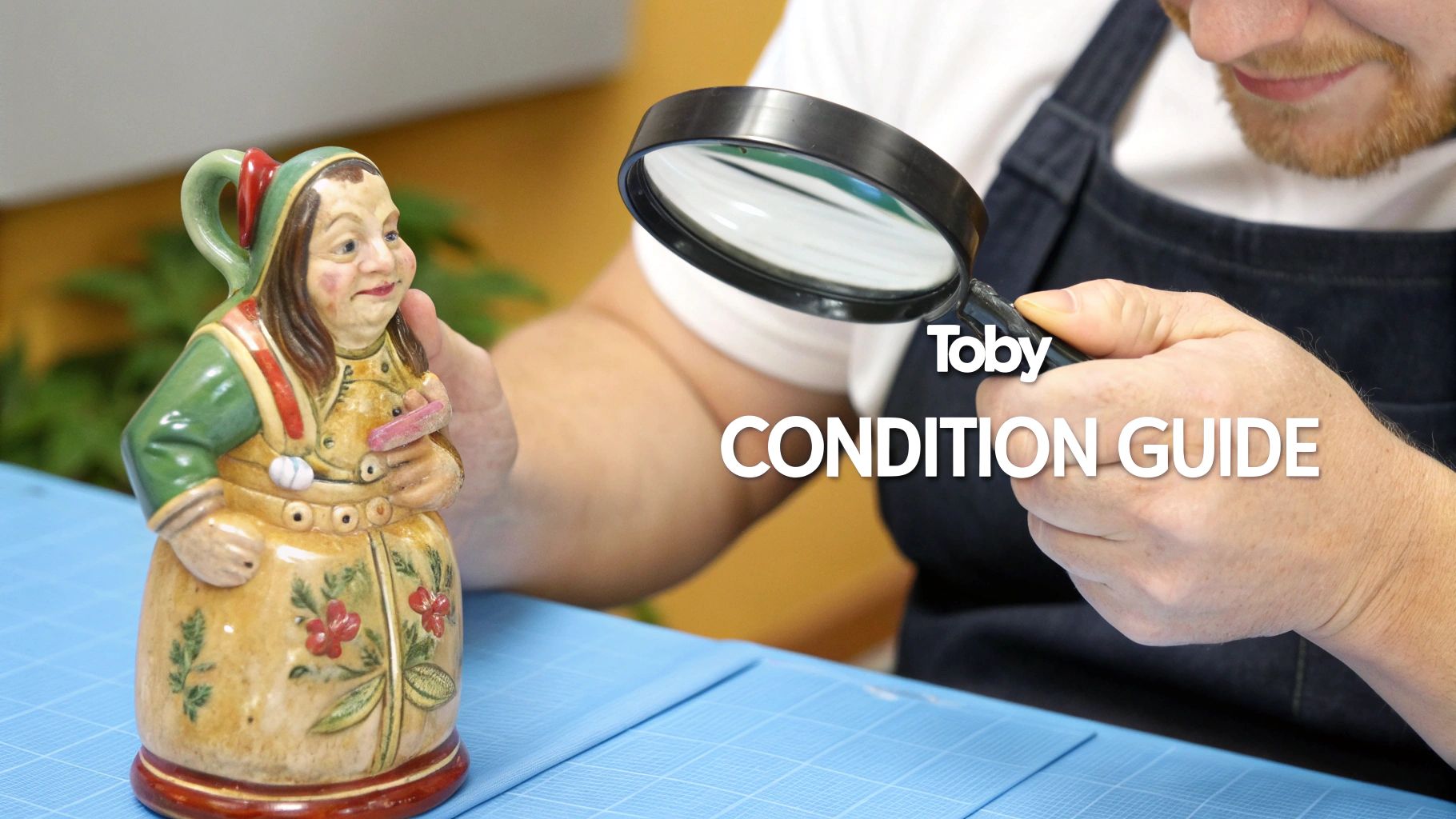
When it comes to antiques, condition is everything. A rare 18th-century Toby jug can plummet in value by a staggering 50-70% because of a single crack or a shoddy repair. It's the difference between a mint-condition comic book and a beautifully restored classic car—both are desirable, but they play in entirely different leagues.
Even the tiniest imperfections can dramatically alter the final price tag. Serious collectors are on the hunt for pieces that have weathered the centuries with their character and integrity intact. Learning to spot the tell-tale signs of wear and tear is one of the most important skills you can develop to understand the true values of Toby jugs.
Your Condition Checklist
Giving a jug a proper once-over is a bit of a process. You’ll want to start with a good visual inspection under bright, natural light. After that, gently run your fingers over the entire surface. You’d be surprised what you can feel that you can’t see. For the serious collector, a blacklight is an indispensable tool for uncovering sneaky, well-hidden repairs.
Here’s a rundown of what to look for, from the most serious issues to the more minor ones:
Chips and Cracks: The most fragile spots are always the rim, the handle, and the base, so check there first. Even a tiny chip, what collectors call a "flea bite," will bring the value down. A hairline crack is a much bigger deal, especially if it snakes through the main body of the jug.
Repairs and Restoration: Older repairs are usually pretty obvious—think mismatched paint or visible glue. Modern, professional restorations are another story and can be incredibly difficult to spot. Look for subtle differences in the sheen or texture of the glaze, as this can be a dead giveaway for overpainting.
Paint Wear and Flaking: Pay close attention to the high points, like the tip of the nose, the brim of the hat, and the curve of the handle. These are the areas that get handled the most, and over decades, the delicate hand-painted colors can simply wear away.
Crazing: These are the fine, web-like lines that often appear in the glaze of old pottery. A bit of light, even crazing is generally accepted as part of an antique's charm. However, heavy or stained crazing can be a turn-off for some buyers and might lower the value.
Condition isn't just about what's broken; it's about how much of the jug's original, untouched character remains. Every flaw tells a part of its story, but the fewer major plot twists, the higher the value.
A Simple Grading System
To put your findings into perspective, it helps to use a basic grading system. This is a simple way to categorize your jug's condition and manage your expectations for its value. The core ideas are universal for most collectibles, and you can learn more about how to appraise antiques professionally to build on these concepts.
- Mint: As perfect as the day it came out of the kiln. Absolutely no flaws.
- Excellent: Might have a tiny bit of shelf wear or a minuscule production flaw, but no chips, cracks, or repairs.
- Good: Could have some light paint wear, minor crazing, or a very small, unobtrusive chip.
- Fair: Shows noticeable damage, like a bigger chip, a hairline crack, or a clearly visible repair.
- Poor: Has significant problems like large breaks, multiple cracks, or extensive, clumsy restoration.
Understanding Rarity and Subject Matter
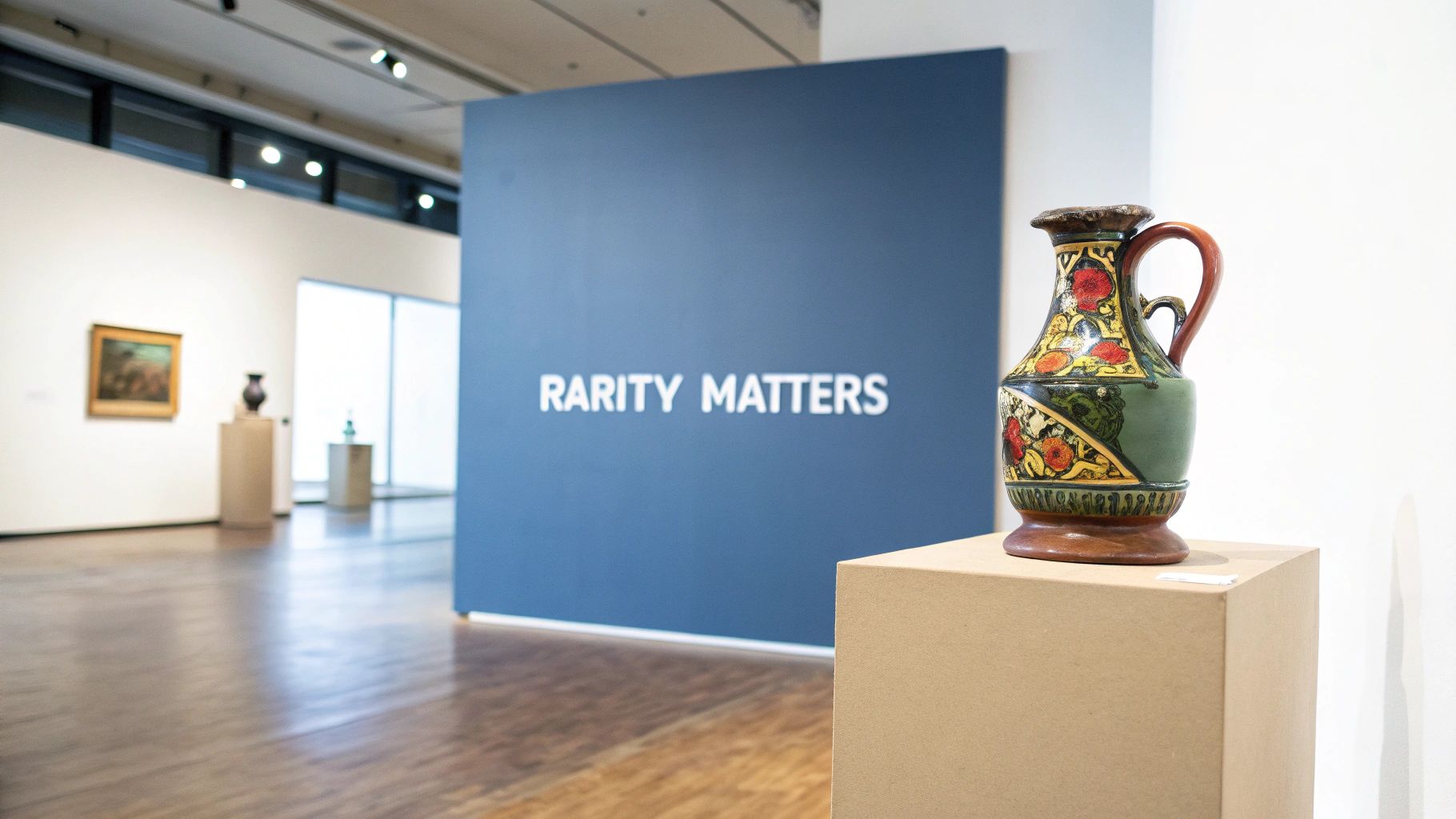
So, why can one Royal Doulton jug be a simple, affordable find while another commands thousands of dollars? Once you've figured out the maker and checked the condition, the answer nearly always comes down to two things: how rare it is and who it depicts. These are the factors that inject real excitement and competition into the market, dramatically influencing the values of Toby jugs.
Rarity isn't just about age. In fact, a 20th-century jug can easily be rarer—and more valuable—than a more common one from the 1800s. Real scarcity is all about the original production numbers. For instance, a standard ‘Winston Churchill’ jug might have been made by the tens of thousands, so they’re pretty easy to find. But a prototype of that same jug? A test piece that never made it to full production? That's a one-of-a-kind treasure.
What Makes a Toby Jug Rare
Rarity isn't a single thing; it comes in a few different flavors. Knowing the difference is how you spot a truly special piece.
- Prototypes and Trial Pieces: Think of these as the test runs. Potteries created them to work out the kinks before finalizing a design. They often have different colors, sizes, or details than the final version you see in stores. Because they are often unique, prototypes are the holy grail for many collectors.
- Limited Editions: This was a smart move by makers like Royal Doulton. They would produce a character jug in a deliberately small, numbered batch. A jug marked "150 of 500" is automatically scarcer than one from an unlimited run, and its value reflects that built-in exclusivity.
- Unusual Colorways: Every so often, a pottery would get creative and experiment with a different color scheme for a standard jug. These "color variations" were typically made in tiny numbers and can be worth much more than their common cousins.
These nuances create a huge spectrum of values. For example, a 20th-century Clarice Cliff Toby Jug might sell for a respectable £130, but a rare Royal Doulton prototype of ‘Neil Armstrong’ soared to an astonishing £3,900. We see the same pattern with prototype character jugs of Marilyn Monroe (£3,100) and Winston Churchill (£3,400), which just goes to show how much uniqueness drives the price. You can dive into more auction results and see for yourself how rarity impacts Toby jug valuations.
The Power of a Popular Face
Beyond the production numbers, the subject of the jug is a massive factor. The character connects the jug to a story, a historical moment, or a cultural icon, and that’s what fuels desire. A jug of a generic, unnamed fellow will almost never be as valuable as one depicting a famous face.
Rarity determines how many jugs exist, but subject matter determines how many people want to own one. The combination of high demand and low supply is the classic recipe for a high-value collectible.
The popularity of the person on the jug can even be more important than the fame of the pottery that made it. A jug of a globally recognized figure—a U.S. President, a legendary musician, or a beloved character from a book—has a much wider audience of potential buyers. This crossover appeal is a powerful force in the market, turning what might be a niche ceramic into a piece of memorabilia that everyone wants.
Navigating Today's Toby Jug Market
https://www.youtube.com/embed/KdFp796XhpQ
Dipping your toes into the Toby jug market can feel a lot like playing the stock market. Trends come and go, prices rise and fall, and a hot item one year might be old news the next. For any collector, understanding market value and ROI isn't just business jargon; it's the key to making smart decisions when you decide to buy or sell.
Let's be realistic: the huge majority of Toby jugs out there, particularly the 20th-century character jugs from big names like Royal Doulton, aren't going to make you rich. Most of these sell in the $25 to $150 range. The market is flooded with them, which is great for new collectors looking for an easy entry point, but it means they aren't exactly high-growth investments.
But at the very top of the market, it's a completely different world.
The High-Value Antique Market
This is where the real magic happens. Exceptional, early, and genuinely rare Toby jugs are the blue-chip stocks of the antiques world. These are the pieces that get serious collectors excited and fetch incredible prices at auction. The appetite for 18th-century originals is as strong as ever, cementing their status as true investment-grade antiques.
You just have to look at recent auction results. Early jugs from the master potters always spark a bidding war. Take, for instance, a beautiful Ralph Wood "Lord Howe" Toby jug from around 1780 that recently hammered down for over £5,500 after fees. A sale like that proves that 18th-century jugs, especially those with a solid connection to a famous maker, hold their value because they are both old and incredibly hard to find.
The Toby jug scene is really a tale of two markets. On one hand, you have the common 20th-century jugs that are affordable and easy to find. On the other, you have a booming market for rare 18th-century originals, with the best examples setting records at auction.
Where to Buy and Sell Today
Knowing where to trade is half the battle. The right place to buy or sell depends entirely on the kind of jug you have. A little strategy goes a long way in finding the right buyers and getting a fair price.
H3: Finding the Right Venue
Specialized Auction Houses: This is the big league. If you have a high-value, rare, or antique Toby jug, this is where you want to be. Auction houses with ceramics experts on staff draw in knowledgeable collectors from all over the globe who are ready to pay top dollar for the best pieces.
Online Marketplaces (eBay, Etsy): Perfect for the more common, mid-range jugs. These sites give you access to a huge audience of casual collectors and interior designers. Just be prepared for lower prices and a lot of competition.
Antique Malls and Fairs: A fantastic, hands-on option for both buying and selling. As a buyer, you might just stumble upon a hidden gem. As a seller, you get to connect directly with local enthusiasts. The audience is smaller, but the personal connection can make all the difference.
If you want to get a better sense of how Toby jug values compare to other collectibles, our price guides for antiques offer a much broader look at the market.
Your Top Toby Jug Questions, Answered
As you start exploring the world of Toby jugs, you'll find a few questions pop up again and again. It doesn't matter if you're just starting out or have been collecting for years; getting straight answers is the best way to feel confident about what you're buying or selling.
Let's dive into some of the most common questions people have about what their Toby jugs are really worth.
Are All Royal Doulton Toby Jugs Valuable?
Not always. While Royal Doulton is one of the biggest names in the game, they made a lot of character jugs, especially after WWII. This means that many of them are quite common, which keeps their value modest.
The real money in Royal Doulton is in the rare stuff: limited editions, early prototypes, and pieces designed by famous artists like Charles Noke. A standard, mass-produced jug from a later period just won't command the same price.
Does a Small Chip Really Affect the Value That Much?
Oh, absolutely. For serious collectors, condition is everything. A seemingly tiny chip, a faint hairline crack, or even a little "flea bite" on the rim can easily cut a jug's value by 50% or more.
And if it's been restored? Even a masterful repair job will drop the price significantly. The most valuable jugs are the ones that have survived in perfect, untouched condition.
Where Is the Best Place to Sell My Toby Jug?
The right place to sell really depends on what you have. You need to get your jug in front of the right buyers to get the best price.
- High-Value Pieces: If you think you have a rare 18th-century jug or a prototype, a specialized antique auction house is the way to go. They have a built-in audience of serious collectors ready to spend big for the right piece.
- Mid-Range Jugs: For more common jugs or those with mid-level value, online marketplaces like eBay or Etsy can work great. The trick is to take crystal-clear photos and write an honest, detailed description that notes every single flaw.
Ready to uncover the story and value behind your own finds? The Curio app puts an antiques expert in your pocket. Snap a photo to get instant identification, historical context, and an estimated appraisal. Download Curio today at https://www.curio.app and let your antiques tell their story.
